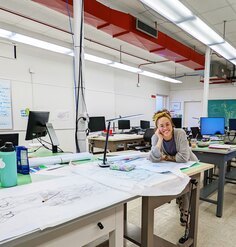Olmsted Scholar Feature: Ocean Planning to Advance New York's Renewable Energy Frontier
By Liz Podowski, 2013 University Olmsted Scholar
New York State is planning for a sustainable energy future — a future that addresses the causes of climate change, diversifies and modernizes the State’s energy system, and expands the renewable energy frontier from land into the ocean. Currently, the ocean provides a vast, untapped source of renewable energy, with winds that are stronger and steadier than land-based wind.
With millions of people living in ocean-front counties, offshore wind is an almost inevitable resource for New York to develop. However, wind energy development in the U.S. has historically focused entirely on land due to past technological constraints. To ensure that New York State responsibly and efficiently takes advantage of this resource as it becomes increasingly accessible, the New York Department of State (NYDOS) is spearheading a planning process in a nearly 16,000 square mile swath of the Atlantic Ocean.
Ocean planning is significantly different from land use planning. First, all ocean lands are held in public trust and are managed by either the state or federal government, depending on distance from shore. The freedom to navigate these “open seas” is a deeply-held value among mariners and poses an inherent challenge to siting permanently-fixed structures, like wind turbines. Second, the ocean environment is dynamic, multidimensional, and largely unknown. At first glance, the ocean may appear to be a homogenous sheet of blue water. But a closer look reveals seabirds foraging above and below the surface, marine mammals migrating large distances, delicate corals colonizing the ocean floor, fishing vessels pulling nets through the water column, and shipping vessels transporting goods from port to port. Even physical characteristics are highly variable, whether vertically with depth or horizontally with currents and weather patterns. Taken together, this complexity necessitates a planning approach that seeks compatibilities among uses and resources (as opposed to zoning, which often discreetly separates them).
NYDOS is developing a collaborative framework to proactively document and analyze existing uses and resources within this busy, complex, public place. Rather than conduct costly field studies of the entire area, NYDOS relies on the iterative aggregation and analysis of existing datasets to better understand the spatial and temporal distribution of ocean uses and resources. Partnerships are critical to this innovative process. Staff collaborated with federal, regional, state, local, and public stakeholders to synthesize, analyze, and translate extensive (and often disparate) datasets. For example, NYDOS organized a series of participatory mapping events with Long Island residents to better understand the type and location of recreational ocean uses — from surfing to wildlife viewing. This information is included in the New York Offshore Atlantic Ocean Study released in July.
Over the course of the next few months, NYDOS will further investigate the potential compatibility of offshore wind projects with ocean uses and resources throughout the development lifecycle — from site surveys to decommissioning. These “compatibility analyses” are critical to ensuring the success of future wind energy projects, as well as the continued viability of the ocean economy and the health of the ocean ecosystem.
Liz Podowski is a NOAA Coastal Management Fellow working with the New York Department of State in the Office of Planning and Development. She received an MLA from the University of Oregon in June 2013.











